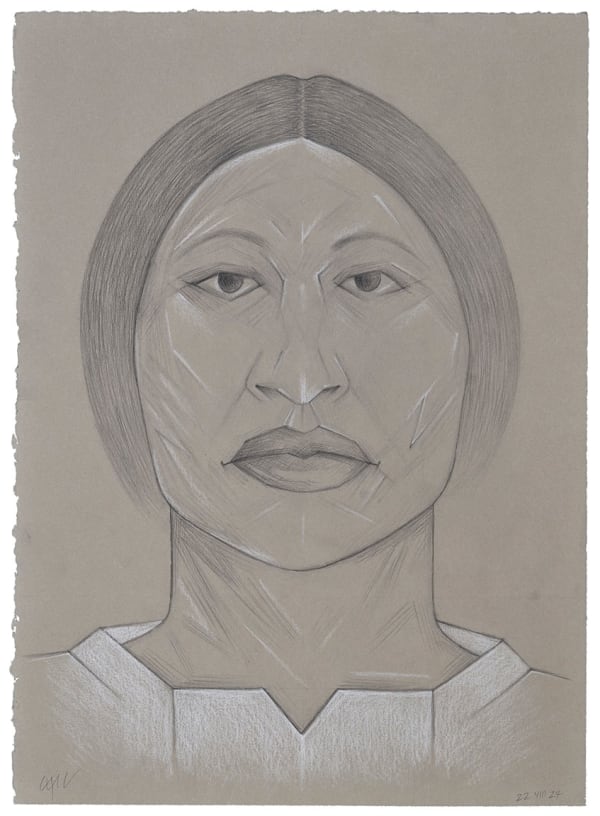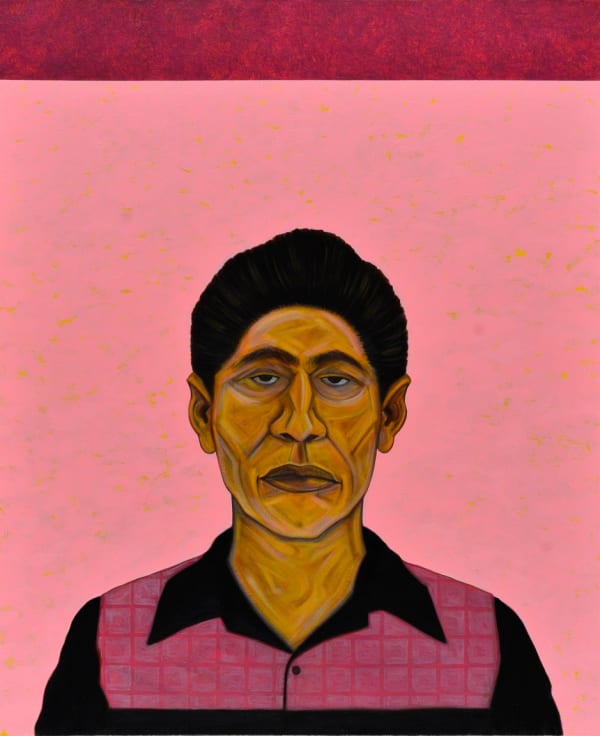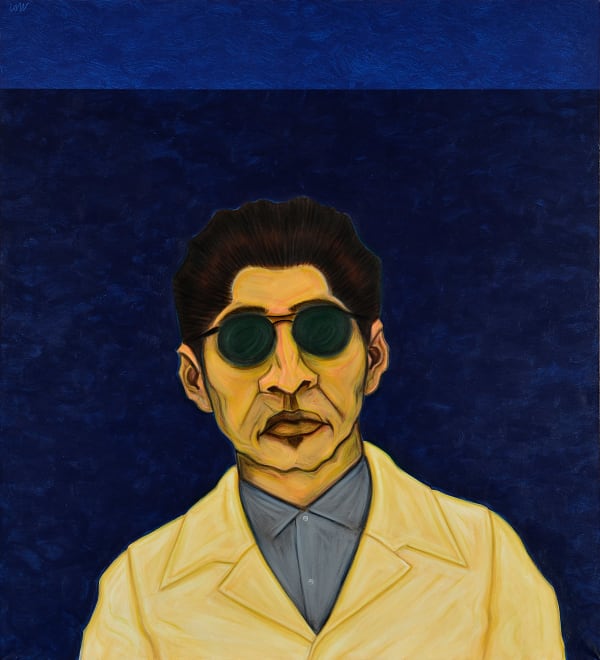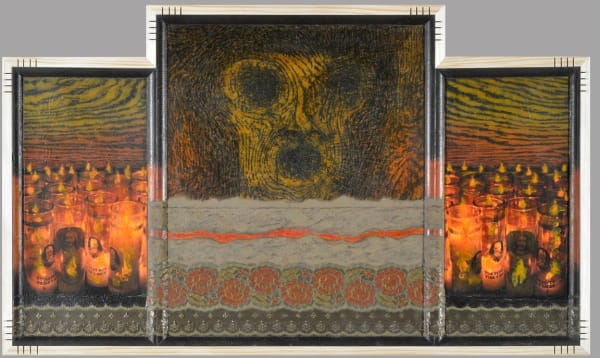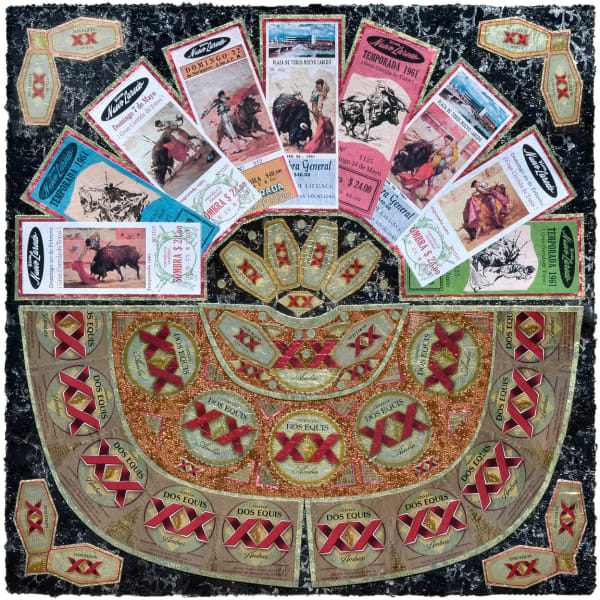-
César A. Martínez: Smoke & Mirrors
-
Ruiz-Healy Art is pleased to present César A. Martínez: Smoke & Mirrors, on view at our San Antonio gallery from October 24th to November 30th, 2024. An opening reception will be held on Thursday, October 24th, from 6:00 to 8:00 PM. A fully illustrated catalogue will be published alongside an essay written by Santos G. Martinez Jr., curator of the landmark 1977 Houston Contemporary Arts Museum exhibition Dále Gas: Chicano Art of Texas. Smoke & Mirrors marks the artist's third solo exhibition with the gallery. César A. Martínez: Smoke & Mirrors encompasses several of the artist's most acclaimed series, Bato/Pachuco, Serape, and Collage, and will highlight the varied range of mediums, experimentation, and innovation used by Martínez throughout his over fifty-year career. Linoleum relief prints, watercolor paintings, graphite drawings, and acrylic paintings will be exhibited.
-
"In using old photographs as a point of reference, the characters seen in Martinez’ portraits are fictitious and void of emotion. However, they are based on real people. At its core, his series of portraits is about identity, Chicano identity. Whether individually or collectively, they represent a cultural portrait of a working-class community, often marginalized, and one which generally goes unnoticed."
- Santos G. Martinez Jr.
-

César A. Martínez
Simon Novoa, 2024Acrylic on canvas
64 x 54 in
162.6 x 137.2 cm -
By utilizing various visual sources such as obituary pictures from the local papers, high school yearbook pictures, and the media, Martínez’s bato and pachucos are created. “Though based on real individuals, calculated liberties are taken with visual facts to “universalize” a character and make him so readily recognizable as to elicit an “I know him!” response from the viewer. Through this approach, I can explore a range of human attitudes within a somewhat clinical context and perhaps give a more accurate visual portrayal than what popular culture can provide. I know I am done with a particular piece when I sense that the character has taken on a life of its own.” says Martínez.
-
-
In Martínez’s 1999 McNay Art Museum catalogue, César A. Martínez : A Retrospective, art historian and scholar, Jacinto Quirarte interviewed Martínez. The artist recounts his early years in the art world, when he went to California to meet with other artists, including Salvador Torres, also known as “El Queso,” who began to influence the early work of the pachuco series. Martínez mentions Torres’ profound influence on his work, “He had some sketchbooks, and I went through them. And I saw some of the most stunning images of Chicanos I had ever seen and said, ‘I want to do stuff like that,’ it moved me.” These sketches drew Martínez toward the qualities of the Chicano community, specifically during a time when only white individuals or groups were featured in portraiture.
-
-
"What we have before us are representations of men and women, in which drawing and color work together in the construction of the image... Their titles would not be necessary to identify them as Mexican Americans among whom indigenous traits correspond to a social class, coinciding with the experience of migration and displacement from ancestral lands. Through the ingenious use of chiaroscuro, the eyes, mouths and noses refer to a post-colonial experience with roots that refer to the artist’s own ancestry. The use of colors in the skin corresponds to color politics in society at large, where bodies are perceived in nuanced tonalities, mestizaje, and skin color obviously plays a fundamental role in the construction of identity."
- Rodrigo Moura, COLORS AND FACES, CÉSAR A. MARTÍNEZ MI GENTE, 2022 exhibition catalogue
-
 César A. MartínezPapalote, 1980Acrylic on canvas50 x 50 in
César A. MartínezPapalote, 1980Acrylic on canvas50 x 50 in
127 x 127 cm -
 César A. MartínezSerape: Pirulí 28 IX 23 (2), 2023Acrylic on Arches watercolor paper22.5 x 30 in
César A. MartínezSerape: Pirulí 28 IX 23 (2), 2023Acrylic on Arches watercolor paper22.5 x 30 in
57.1 x 76.2 cm -
-
Martínez’s artwork interweaves narratives of survival and cultural identity, drawing inspiration from his South Texas origins. His Cabeza de Vaca Stele reflects Alvar Nuñez Cabeza de Vaca’s journey, merging Native American rock art and Mesoamerican traditions. In Three Rivers Petroglyph, he elevates everyday objects by framing them with Jornada Mogollon motifs, connecting ancestral narratives to contemporary identity. His exploration culminates in The Scream in South Texas: La Llorona, where religious imagery meets folklore, inviting reflection on loss and grief.
-
Martínez works with collaging classic labels from Mexican beer brands Dos XX, Carta Blanca, and Tecate. As seen in both Capote de Paseo (Ambar) and (Lager), the recognizable colors and typeface of the Dos Equis metallic foil have been paralleled with tickets to Nuevo Laredo’s Plaza de Toros, referencing the traditional regard for design seen in the lustrous patterns of the capote de paseo worn by toreros, often adorned with shimmering gold ornamentation and floral imagery.
-
-
In 1986, Martínez read a book that contained an image of a work by Picasso, a “straightforward charcoal drawing of a bull, just the head, and it seemed to have a human face in it.” From then on, Martínez acknowledged his connection and high regard for toros and bullfighting. This detail also became a key origin point for the artist’s Mestizo series, reflecting race, geographical origin, and the impact of European influence.
-
"For much of his life, starting at the age of 14, Martinez was obsessed with bullfighting. He wanted to become a bullfighter, and he trained with professional bullfighters in Nuevo Laredo who practiced with heifers — young, female fighting stock — during tientas, the testing of the young females for breeding purposes. Martinez never became a professional bullfighter, and he never killed a bull... In his earlier days Martinez was transported by the romance of the art of bullfighting, and he turned a blind eye to its cruelties, though they did disturb him."
- Ruben C. Cordova, Blending Mexican History, Bullfighting, Spanish Art, and Opera: Cesar Martinez’s La Malinche As Carmen
-
Martínez was born in Laredo, Texas, and graduated from Texas A&I University, Kingsville in 1968. He has lived and worked in San Antonio, Texas, for decades.
A significant figure in the early 1970s and 1980s Chicano Art Movement and deeply rooted in his native South Texas and Mexican American culture, Martínez's work reflects a broad knowledge of the Western art canon and finds inspiration from color-field paintings, Mexican architecture, and photography. Martínez's work has been included in landmark exhibits like Hispanic Art in the United States: Thirty Contemporary Painters & Sculptors; La Frontera/The Border: Art About the Mexican/U.S. Border Experience; and Chicano Art: Resistance and Affirmation 1965-1985. In 2009, the McNay Art Museum, San Antonio, TX, gave Martinez's work a solo exhibition with an accompanying publication book. The artist's work is broadly collected at the McNay Museum as well. His work is part of the permanent collection of institutions like The Museum of Modern Art, New York, NY; The Whitney Museum of American Art, New York, NY; Brooklyn Art Museum, Brooklyn, NY; National Gallery of Art, Washington, D.C.; the Museum of Fine Arts, Houston, TX; San Antonio Museum of Art, San Antonio, TX, and the Mexican Fine Arts Center Museum, Chicago, IL., among others.
César A. Martínez: Smoke & Mirrors: San Antonio
Past viewing_room





